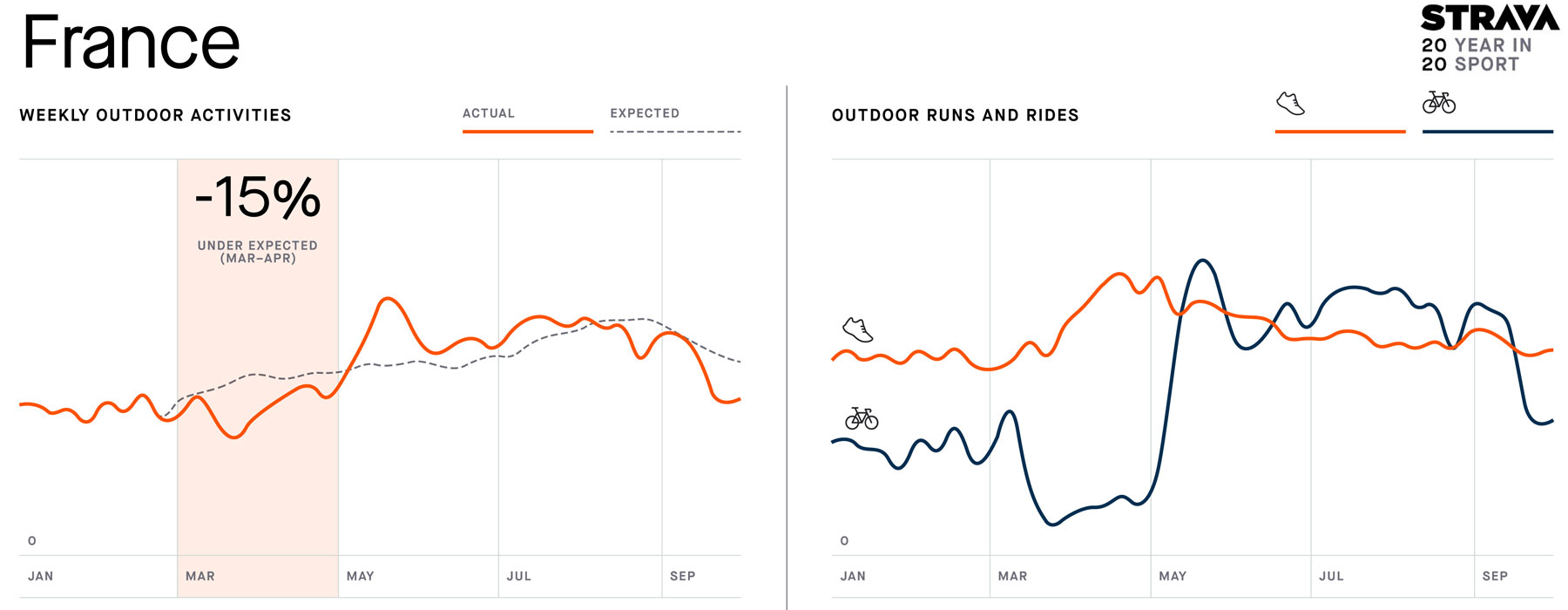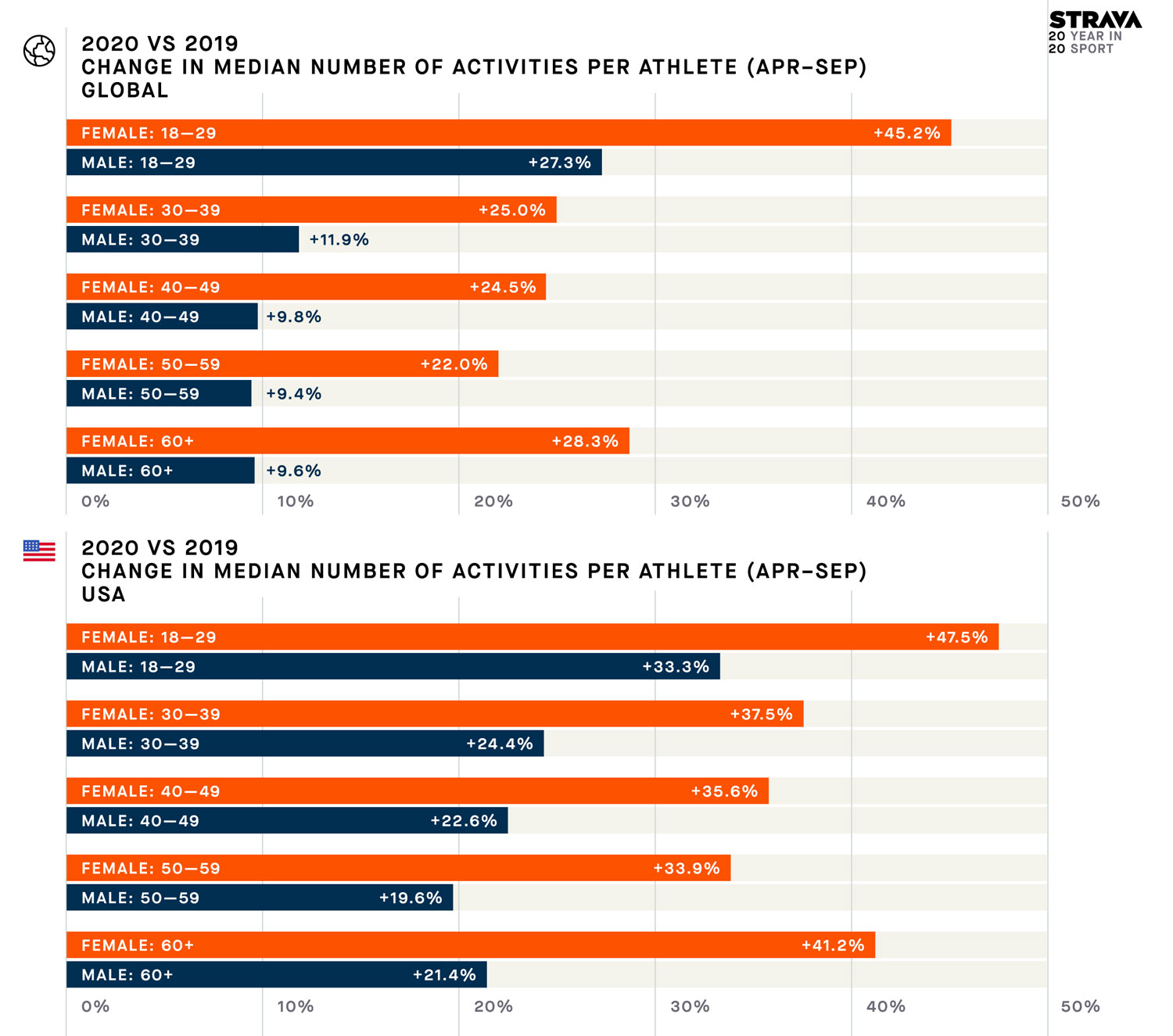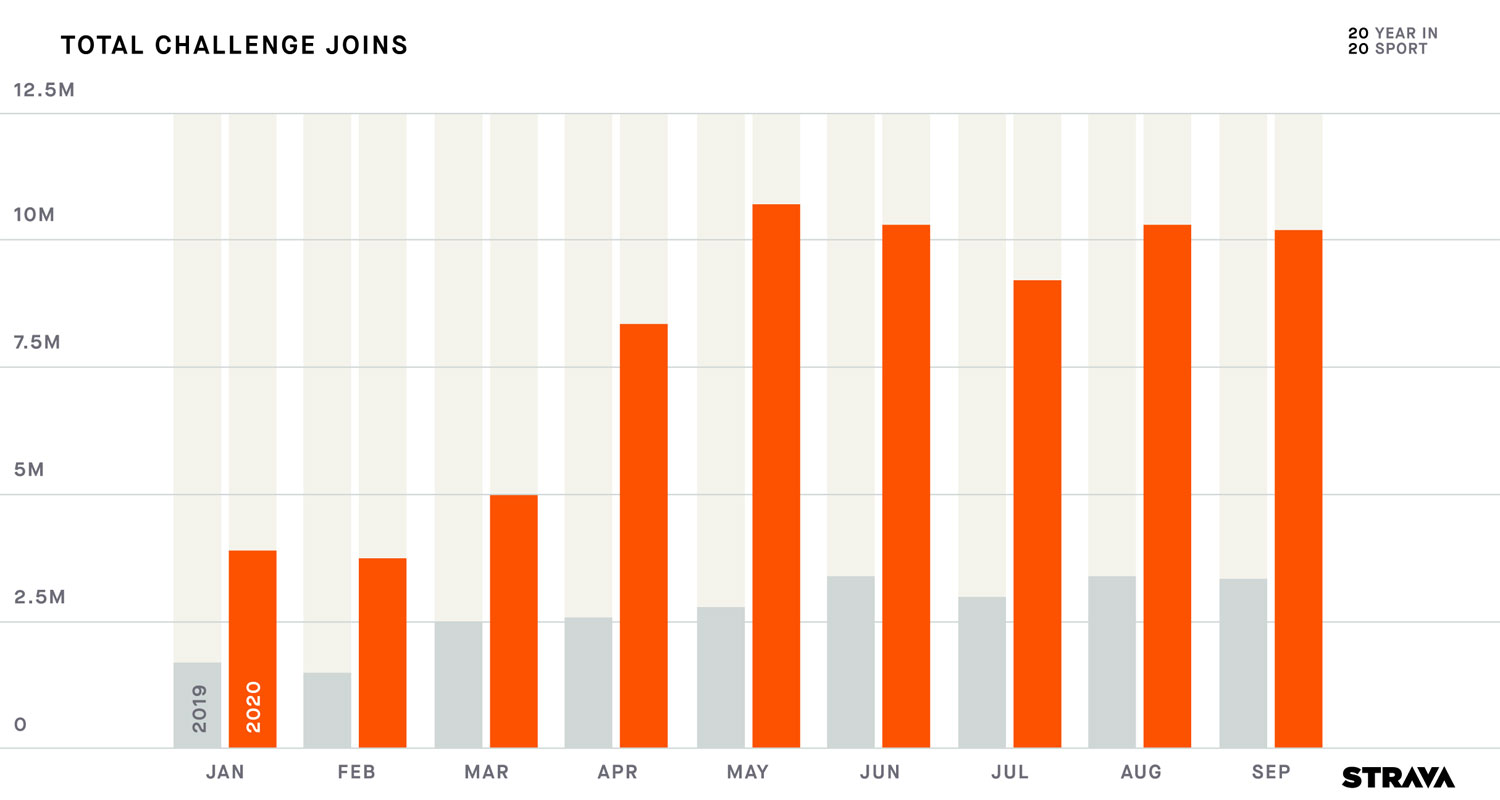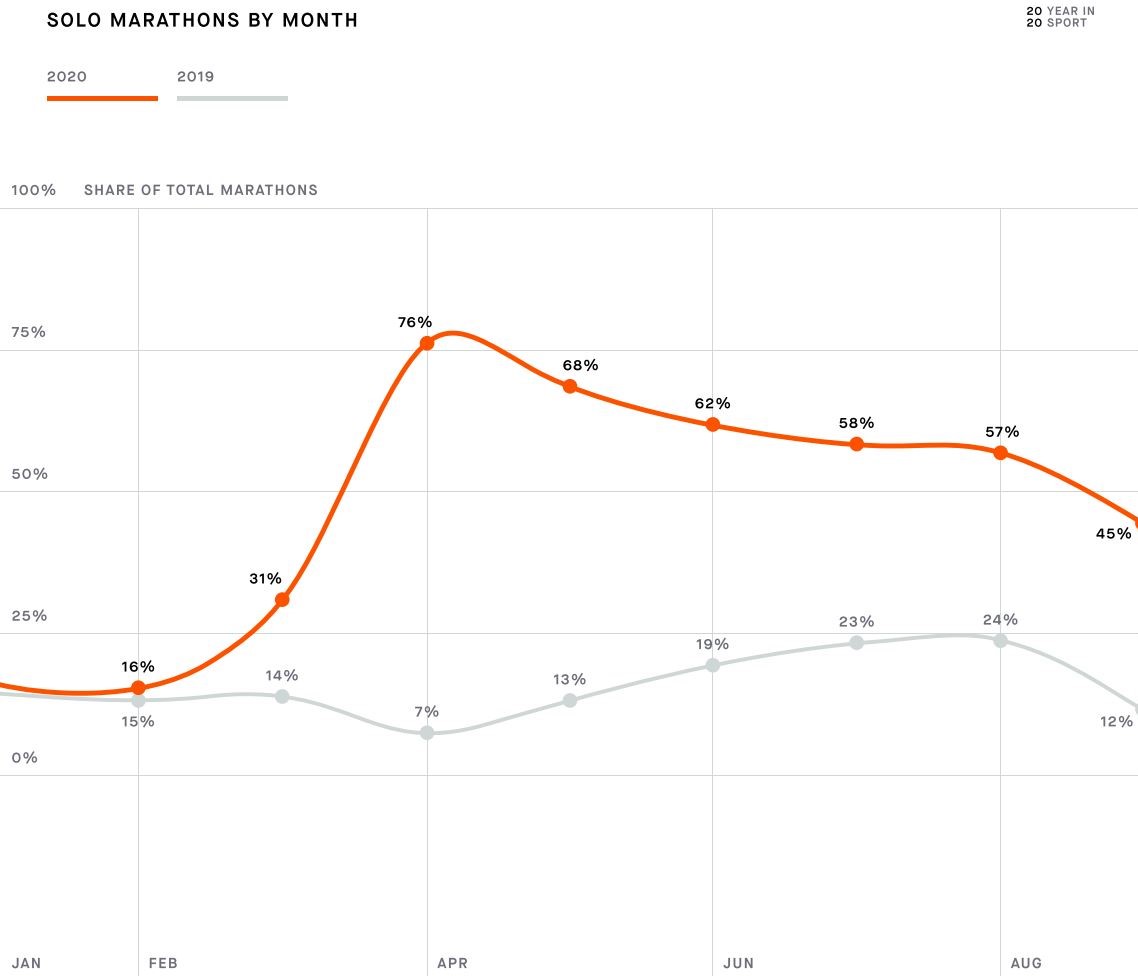Strava data reveals active lifestyle during pandemic

Strava Report (COVID edition)
The 2020 Strava Year in Sport data report is in, and it provides some interesting insights into how the endurance community across the world has responded to the COVID-19 pandemic. For those not familiar, Strava is an online platform for tracking exercise activities and has a few social network features. It is currently the leading social platform for athletes, and largest sports community in the world with over 73 million athletes. Individuals can record or upload their own activities, track their exercise progress over time, and share, view, and comment on other athletes’ activities. The platform is most popular with cycling, running, and triathlon communities, but many different types of activities can be recorded, including walking, hiking, skiing, yoga, and weightlifting. The 2020 report represents some (not everyone logs every activity on Strava) of the exercise activity levels of the 73+ million users, and how their exercise routines have changed from previous years.
Active lifestyle during pandemic
As daily routines were disrupted, many turned to exercise during the pandemic. There was a global boom in activity level, with users increasing activity frequency by 13%. Despite uploading more activities, the duration of each activity remained about the same, resulting in a 15% increase in yearly moving time. This increased activity level is especially apparent in the early stages of the pandemic when life was most disrupted. Now that people are adapting to remote work and many countries are reopening, activity levels appear to be returning to normal levels, but remain elevated from previous years.
Strava reports that users logged an average of 21.5 million activities per week in 2020, a 33% increase from 2019. Further, there were over 2 million new users joining the platform each month during 2020 (yes, over 24M new users since last year). There has also been an enormous growth in walking, hiking, and cross-training activities, such as kayaking, yoga, and weightlifting, on their platform. This is likely a compound effect of both more users on the platform, as well as increase in free time, focus on mental health, and desire to get outside the house.
Activity levels during lockdown (March and April)

The Strava report also provides some insights into how different countries responded to the virus. In countries with fewer restrictions on outdoor activities, such as the US, UK, Ireland, and Germany, outdoor activities skyrocketed. In the UK and Ireland, there was an 82% increase in outdoor activity levels. While this increase is likely inflated by the closure of indoor gyms during this time, elevated outdoor activity persisted through the rest of the summer, as exercise continued to be an outlet for individuals around the world.

Several countries like France, imposed time and distance restrictions on outdoor activities. Limited to one hour of activity within one kilometer of home, many French athletes turned from cycling to running during March and April. Once limitations were relaxed, athletes quickly jumped back on their bikes to enjoy the rest of the summer weather. This is especially interesting since many cyclists balk at the idea of running.

In Spain and Italy, strict lockdowns resulted in a 65% decrease in outdoor activity levels during March and April. At the same time, these countries saw a 3.6x increase in indoor activity levels, as athletes turned to indoor bike rides, treadmill runs, yoga, and weightlifting. Soon after restrictions were lifted, athletes were back outside to enjoy the fresh air with mostly solo activities.
Routine shifts

The change is more pronounced in the UK and Ireland.
As people adjusted to new routines, workout schedules started to look a little different. Morning runs and bike rides tended to start later in the day, and activities in general were spread throughout the day more than in 2019, no longer crammed in short windows outside of work hours. Further, training loads were spread out more evenly throughout the week, as opposed to being concentrated on the weekend.

Perhaps the most surprising statistic is how much more women increased their exercise regimen than men. Across all age groups worldwide, women increased the number of activities logged in 2020 from 2019 by 30%, compared to men at 13%. The same trend persists in the US, with the largest increase for both genders occurring in the 18-29 age group.
Competition
2020 also saw the cancellation of nearly all in-person races and mass start events, including marathons, 5Ks, cycling races, and a handful of triathlons. However, the competitive spirit of the endurance community remained, and athletes found new ways to compete virtually. Virtual races saw an all-time high in participation. Strava had almost 1.2 million members join the May 5K challenge, marking a new record for the company. Other, traditionally in-person race companies began offering more virtual races, complete with shipment of the usual race swag and finisher medal.

Similarly, informal competition saw new heights. Strava tracks the fastest athletes to complete specific segments or small stretches of a workout path that is frequented by many athletes, such as the running path around the park or the bike route down the block. The male and female leaders for these segments claim the title of KOM (King of the Mountain) or QOM (Queen of the Mountain) for cycling, or CR (Course Record) for running. These titles saw a record number of turnovers in 2020, up over 34% from 2019. With these turnovers, there was only a 27% chance that the top two leaders on any given segment, thought of as the two competing for bragging rights, were following each other on Strava, meaning competition was not just between friends but within the community.

Competitive athletes continued to compete in the absence of official races, and competition within the community was fostered virtually. Lower stakes virtual competitions replaced social group activities, and Strava saw 2-3x more virtual challenges joined by their members in 2020 than in 2019.

With the cancellation of official marathons, there were fewer 26.2 mile runs logged in 2020 than in 2019, although there were still several hundred thousand. What’s impressive, is that 44% of these marathons were run solo, compared to just 14% in 2019. In April, during the height of the pandemic, we saw as much as 76% of marathons were endured solo. There were even a couple marathons logged on balconies, driveways, and other incredibly small loops [1, 2, 3]. Further, for users active since at least 2019, 55% logged a personal best time in their 5K, 10K, half marathon, or marathon distances in 2020.
Summary
Countries around the world responded to COVID-19 in various ways, imposing lockdowns, curfews, work from home policies, and social distancing guidelines. Data recorded by millions of users on the Strava platform indicates that despite these restrictions, exercise remains an essential part of our lifestyle. Users became more creative with how they worked out, and on average spent 15% more time being active than in 2019. Workout times shifted to accommodate new work lifestyles, and in-person races were replaced by virtual competitions.
It is difficult to know for certain the causes of the 2020 Strava trends we observe. The increasing popularity of Strava is an obvious confounding variable; however, many events correlate very well with COVID milestones. Data from the 2021 and 2022 Strava Year in Sport reports will help identify trends related to increased users and interest in logging activities online, versus short-term behavioral changes related to the pandemic.
You can access the Strava report directly from https://blog.strava.com/press/yis2020/




